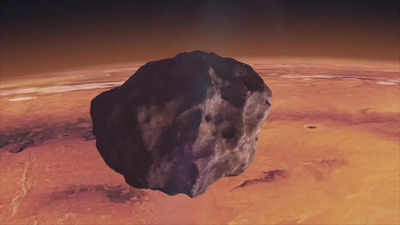- News
- Science News
- James Webb Space Telescope unveils devastating asteroid collision in neighbouring star system
James Webb Space Telescope unveils devastating asteroid collision in neighbouring star system
The James Webb Space Telescope detected evidence of a massive collision between two giant asteroids in the Beta Pictoris star system, releasing a dust cloud 100,000 times larger than the one that caused the extinction of dinosaurs on Earth.

The James Webb Space Telescope (JWST) has detected evidence of a massive collision between two giant asteroids in a nearby star system. This significant event resulted in the release of a dust cloud 100,000 times larger than the one generated by the asteroid impact that caused the extinction of the dinosaurs on Earth.
According to Live Science report, the colossal collision took place in the Beta Pictoris star system, located 63 light-years away in the constellation Pictoris.Beta Pictoris, a relatively young star system at only 20 million years old, was first identified in 1983 by NASA's Infrared Astronomical Satellite (IRAS) spacecraft. Scientists believe it formed from the shockwave of a nearby supernova.
The circumstellar debris disk surrounding Beta Pictoris—a vast ring of gas and dust—is much more violent compared to our solar system’s. This makes it an ideal location for astronomers to study the chaotic early stages of planet formation. The researchers believe their findings could provide valuable insights into the history of our own solar system.
"Beta Pictoris is at an age when planet formation in the terrestrial planet zone is still ongoing through giant asteroid collisions, so what we could be seeing here is basically how rocky planets and other bodies are forming in real time," said Christine Chen, an astronomer at Johns Hopkins University and lead author of the study.
To capture the asteroid collision, the astronomers used JWST to observe the system. They noted that massive clumps of silicate dust, previously observed by the Spitzer Space Telescope between 2004 and 2005, had vanished. This suggests that a gigantic collision between two asteroids likely occurred around 20 years ago, pulverising the bodies into vast quantities of fine dust.
"With Webb's new data, the best explanation we have is that, in fact, we witnessed the aftermath of an infrequent, cataclysmic event between large asteroid-size bodies, marking a complete change in our understanding of this star system," Chen added.
The researchers believe their findings will aid astronomers in understanding the formation of star systems and the frequency of habitable systems like our own.
"The question we are trying to contextualise is whether this whole process of terrestrial and giant planet formation is common or rare, and the even more basic question: Are planetary systems like the solar system that rare?" said Kadin Worthen, a doctoral student in astrophysics at Johns Hopkins University and study co-author. "We're basically trying to understand how weird or average we are."
These observations by JWST contribute to the broader understanding of planetary system formation and the potential commonality of systems similar to our own.
Colossal asteroid collision
According to Live Science report, the colossal collision took place in the Beta Pictoris star system, located 63 light-years away in the constellation Pictoris.Beta Pictoris, a relatively young star system at only 20 million years old, was first identified in 1983 by NASA's Infrared Astronomical Satellite (IRAS) spacecraft. Scientists believe it formed from the shockwave of a nearby supernova.
Characteristics of Beta Pictoris
Despite having at least two gas giant planets, Beta Pictoris does not currently have any known rocky planets like Earth. However, researchers suggest that rocky inner planets could be forming due to large dust-producing collisions, such as the one observed by JWST. The findings were presented on June 10 at the 244th Meeting of the American Astronomical Society in Madison, Wisconsin.
Significance of the debris disk
The circumstellar debris disk surrounding Beta Pictoris—a vast ring of gas and dust—is much more violent compared to our solar system’s. This makes it an ideal location for astronomers to study the chaotic early stages of planet formation. The researchers believe their findings could provide valuable insights into the history of our own solar system.
"Beta Pictoris is at an age when planet formation in the terrestrial planet zone is still ongoing through giant asteroid collisions, so what we could be seeing here is basically how rocky planets and other bodies are forming in real time," said Christine Chen, an astronomer at Johns Hopkins University and lead author of the study.
James Webb Space Telescope observations
To capture the asteroid collision, the astronomers used JWST to observe the system. They noted that massive clumps of silicate dust, previously observed by the Spitzer Space Telescope between 2004 and 2005, had vanished. This suggests that a gigantic collision between two asteroids likely occurred around 20 years ago, pulverising the bodies into vast quantities of fine dust.
"With Webb's new data, the best explanation we have is that, in fact, we witnessed the aftermath of an infrequent, cataclysmic event between large asteroid-size bodies, marking a complete change in our understanding of this star system," Chen added.
The researchers believe their findings will aid astronomers in understanding the formation of star systems and the frequency of habitable systems like our own.
"The question we are trying to contextualise is whether this whole process of terrestrial and giant planet formation is common or rare, and the even more basic question: Are planetary systems like the solar system that rare?" said Kadin Worthen, a doctoral student in astrophysics at Johns Hopkins University and study co-author. "We're basically trying to understand how weird or average we are."
These observations by JWST contribute to the broader understanding of planetary system formation and the potential commonality of systems similar to our own.
End of Article
FOLLOW US ON SOCIAL MEDIA
